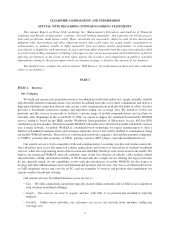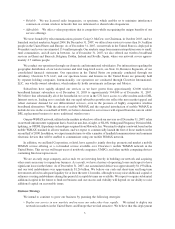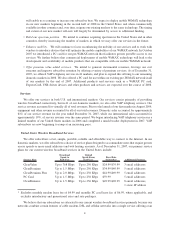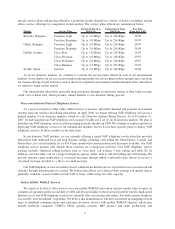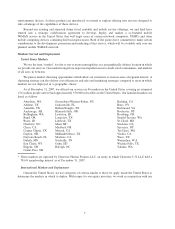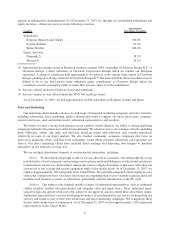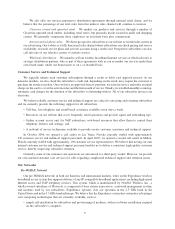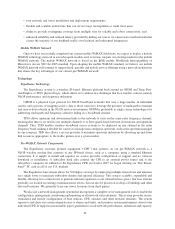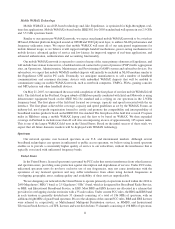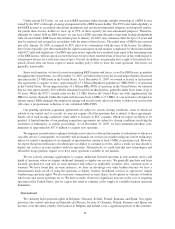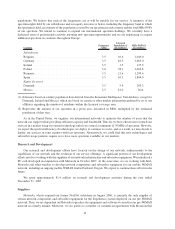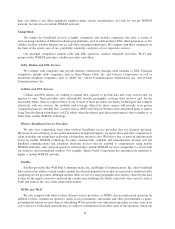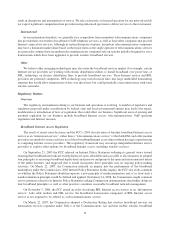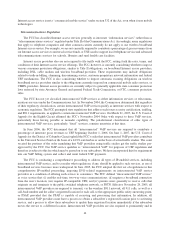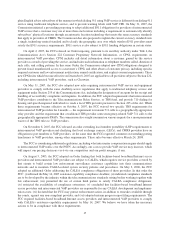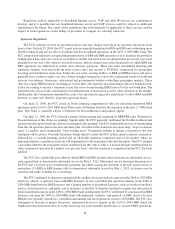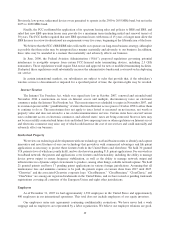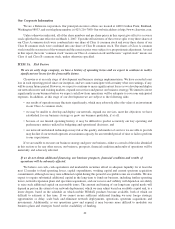Clearwire 2007 Annual Report Download - page 18
Download and view the complete annual report
Please find page 18 of the 2007 Clearwire annual report below. You can navigate through the pages in the report by either clicking on the pages listed below, or by using the keyword search tool below to find specific information within the annual report.• easy network and tower installation and deployment requirements;
• flexible and scalable architecture that can service large metropolitan or small rural areas;
• ability to provide overlapping coverage from multiple sites for reliable and robust connectivity; and
• enhanced reliability and reduced latency provided by linking our towers via a microwave mesh network that
carries the majority of our backhaul traffic over licensed and unlicensed frequencies.
Mobile WiMAX Network
Once we have successfully completed our current mobile WiMAX field trials, we expect to deploy a mobile
WiMAX technology network in our subsequent markets and, over time, migrate our existing markets to the mobile
WiMAX network. The mobile WiMAX network is based on the IEEE mobile Worldwide Interoperability of
Microwave Access 802.16e-2005 standard. Upon adopting the mobile WiMAX standard, we believe our mobile
WiMAX network will continue to support fixed, portable and mobile service offerings using a network architecture
that shares the key advantages of our current pre-WiMAX network.
Technology
Expedience Technology
The Expedience system is a wireless IP-based, Ethernet platform built around an OFDM and Time Divi-
sion Duplex, or TDD, physical layer, which allows us to address two challenges that face wireless carriers, namely
NLOS performance and frequency utilization.
OFDM is a physical layer protocol for NLOS broadband networks that uses a large number of individual
carriers and a process of mapping a user’s data to those carriers to leverage the presence of multi-path to transmit
and receive data robustly in the NLOS service environment. OFDM is preferable to single carrier technologies for
addressing multi-path and frequency-selective fading in a broadband channel.
TDD allows upstream and downstream links to the network to exist on the same radio frequency channel,
meaning that there is no need to use multiple channels or to have guard-bands between downstream and upstream
channels. Thus, TDD enables wireless broadband access systems to be deployed on any channel in the radio
frequency band, making it flexible for carriers to manage non-contiguous spectrum, such as the spectrum managed
by our company. TDD also allows a service provider to maximize spectrum utilization by allocating up and down
link resources appropriate to the traffic pattern over a given market.
Pre-WiMAX Network Components
The Expedience customer premise equipment (“CPE”) that operates on our pre-WiMAX network is a
NLOS wireless modem that connects to any IP-based device, such as a computer, using a standard Ethernet
connection. It is simple to install and requires no service provider configuration or support and no software
download or installation. A subscriber need only connect the CPE to an external power source and to the
subscriber’s computer. In addition to the Expedience CPE, in October 2007 we began offering our True Broad-
band
TM
PC card in all of our U.S. markets.
The Expedience base station allows for 360 degree coverage by employing multiple transceivers and antennas
on a single tower to maximize subscriber density and spectral efficiency. This setup is scalable, expandable and
flexible, allowing us to control costs to promote efficient expansion as our subscriber base grows. Our base stations
generally are located on existing communications towers, but can also be placed on rooftops of buildings and other
elevated locations. We generally lease our tower locations from third parties.
We also use a network management system that incorporates a complete set of management tools to enable the
configuration, management, monitoring and reporting of all network status elements. This system provides secure,
centralized and remote configuration of base stations, CPE, switches and other network elements. The system
reports to and alerts our system administrators to alarms and faults, and monitors system performance down to the
individual CPE. It supports customizable report generation to track network performance, utilization and capacity.
10




